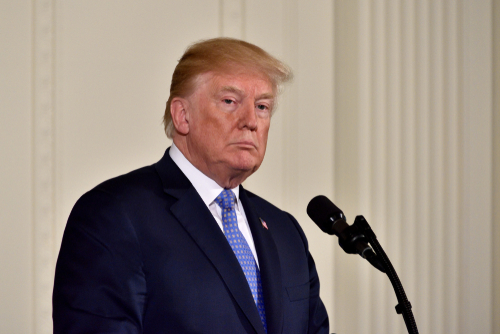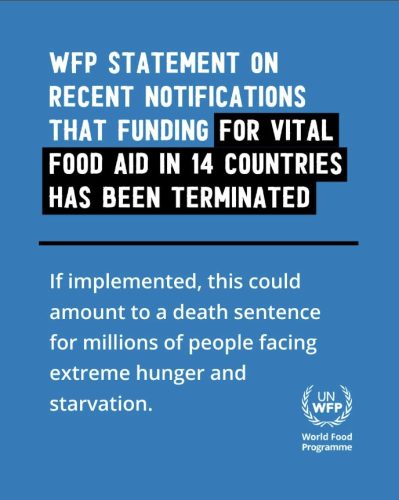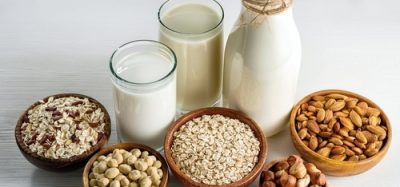Food security in the Trump era: risks and opportunities
Posted: 7 May 2025 | Mark Driscoll | 1 comment
We are living in VUCA times – a phrase that describes the volatile, uncertain, complex and ambiguous nature of today’s world. Here, Mark Driscoll reflects on the perilous challenges presented by President Trump on global food security due to policy shifts affecting trade, community feeding programmes, international aid, agriculture and environmental regulations.


Donald Trump's domestic and international food policies are reshaping the global food landscape — with serious implications for affordability, aid, and agricultural resilience. Credit: Shutterstock
Early in March this year, the US Agriculture Department announced that it would halt $1 billion in federal funding, which was earmarked for programmes that gave schools and food banks money to buy food from local farms. At the same time, food costs have continued to rise over the last three years, with some 13.5 percent of American households (18 million) classified as food insecure in 2023, a significant rise from 2022 (12.8 percent).1 According to Feeding America, in 2023 more than 50 million people turned to food banks, food pantries and community organisations for food assistance. Reliance on these food banks has in turn led to a rise in obesity and diabetes, with food banks often offering foods that are heavily processed and low in fibre.
Rising food costs and increasing reliance on food assistance
Climate-induced heavy rainfall and flooding have already impacted farmers across the Midwest, resulting in significant crop losses. These same farmers are being hit by a double whammy of Trump’s recent tariff announcements, including the 125 percent tax on food commodities such as soybeans, wheat and corn destined for China. For the last 30 years, American and many European farmers have been heavily incentivised through the Farm Bill and the Common Agricultural Policy to grow vast quantities of these crops for export.
The stakes are high for many US citizens already struggling with food inflation — and policy decisions may determine whether millions go hungry.
According to the US Department of Agriculture (USDA), the US imports nearly 60 percent of its fresh fruit and 35 percent of fresh vegetables; the recent imposition of a 10 percent flat tariff on imports, with some goods facing tariffs up to 54 percent, will ultimately burden American consumers, making healthy eating less affordable for many low-income households.
Farm labour shortages will likely be another important factor affecting food prices over the next few years. Given that undocumented farmworkers comprise approximately 42-50 percent of the US agricultural industry, stricter immigration enforcement policies have the potential to impact food production and drive up food prices.
The stakes are high for many US citizens already struggling with food inflation. Food insecurity will remain elevated without significant policy interventions or economic improvements. The continued strain on food assistance programmes and rising food costs due to elevated tariffs and labour constraints suggest that vulnerable populations will face ongoing challenges in accessing healthy and nutritious foods at affordable prices.
So, what about the impacts of Donald Trump’s policies on the rest of the world?
The adage ‘When the US sneezes, the world catches a cold’ is especially true in the context of global food systems. The US remains a critical actor in global food value chains, both as a major exporter of staple commodities and a leading funder of international food aid. As a result, domestic policy shifts in the US reverberate far beyond its borders, affecting food prices, supply availability and humanitarian assistance to the rest of the world.


WFP warns on X “this could amount to a death sentence for millions of people facing extreme hunger and starvation” Credit: World Food Programme via X
One example is the Trump administration’s move to terminate funding to the World Food Programme (WFP) and abolish the USAID programme altogether. The abrupt withdrawal of USAID, worth an estimated $40 billion, for example, has strained global efforts to provide food assistance to low- and middle-income countries, including those regions facing climate-induced food insecurity. The WFP, which relies heavily on US contributions, warned on X that ‘this could amount to a death sentence for millions of people facing extreme hunger and starvation’ unless other donor countries fill the funding gap. Only time will tell what repercussions these overseas aid cuts will have on global food security.
In addition to aid cuts, there will inevitably be compounded impacts. As a result of tariffs on agricultural imports and exports, countries that rely on affordable US grain and soy exports are now facing inflated costs, which cascade through their local economies, pushing food prices higher and increasing the risk of political and social unrest. For example, nations in Sub-Saharan Africa and Southeast Asia, which are highly dependent on food imports, will likely experience volatility in their domestic market over the coming year.
In the UK, the introduction of 10 percent tariffs on all goods exported to the US has intensified discussions around a potential UK-US trade deal. While the UK Government has committed to maintaining existing food safety, environmental and animal welfare standards, there remain some significant concerns about the implications of such a trade agreement. Many farmers and NGOs remain concerned that the unpalatable demands to allow the import of chlorinated chicken and hormone-fed beef could be a pill the UK would need to swallow as part of any deal.
The rollback of US environmental regulations poses further risks to global food security. Weakened protections for biodiversity, climate, waterways, pesticide use and soil conservation threaten the long-term sustainability of agricultural production. In a world that will inevitably face additional shocks in the form of environmental crises (climate change and biodiversity loss), we need policies oriented towards localising and democratising our food systems, building on traditional and ecological knowledge that supports long-term resilience.
Ray of hope
Amid these challenges, there are also opportunities. Rising food prices and trade tensions could prompt renewed investments in local food systems, agrobiodiversity, nutritious foods and sustainable farming practices. These shifts may foster a more diversified and resilient domestic food economy in the long run. Governments could use this to commit to taking measures that build longer-term resilience to future global shocks.
Amid rising prices and political upheaval, there lies an opportunity to build resilient, local food systems that nourish both people and planet.
Internationally, the vacuum created by the US isolating itself from the rest of the world may open the door for other countries to step up and assume leadership roles that reform the whole business of humanitarian food aid. While immediate food aid will remain important at times of crisis, there could be greater opportunity to address the systemic root causes of food poverty and food insecurity. Longer-term structural changes to current external financing are required to reduce the over-reliance on humanitarian assistance and to help tackle the root causes of malnutrition and hunger.
As I write this piece, the impacts of Trump’s rapidly changing policies are still unfolding, and it is too early to assess their impact on global food security. What is certain is that we live in VUCA times, and we must double our efforts to work together to deliver fair, equitable, sustainable, healthy and resilient food systems for all.
Meet the author


Mark is the Founder and Director of Tasting the Future, a purpose-driven not-for-profit sustainable food systems consultancy. He is a global expert and passionate advocate for food systems change. He has over 30 years of experience working with businesses, governments, and civil society organisations on solutions that address some of the key social and environmental challenges confronting our global food system.
References
- Hal J van. Latest USDA report reveals growing food insecurity among US households [Internet]. https://www.nutritioninsight.com. CNS Media.; 2024 [cited 2025 Apr 30]. Available from: https://www.nutritioninsight.com/news/latest-usda-report-reveals-growing-food-insecurity-among-us-households.html
Related topics
Related organisations
Feeding America, The United State Department of Agriculture (USDA), the World Food Programme (WFP)
Related regions
Asia Pacific & Oceania, Europe, Middle East, North America, UK & Ireland










Food policy often flies under the radar, even though it affects everything from global trade to local farming communities. I didn’t realize how much of a ripple effect the Trump-era policies had on global food security until reading this.
The article did a great job highlighting the unintended consequences of tariff wars and reduced foreign aid. It’s easy to forget that when the U.S. shifts its agricultural priorities or trade stance, it doesn’t just affect American farmers—it has huge implications for developing countries that rely on U.S. grain imports or food assistance programs.
Also, the part about deregulation and its potential long-term effects on sustainability and food safety was especially eye-opening. These aren’t just short-term political decisions—they’re choices that shape what we grow, how we grow it, and who gets to eat.
I do wish there had been a little more on how things are shifting under the current administration, just to give a full sense of the trajectory, but overall, this was a really balanced and informative piece.